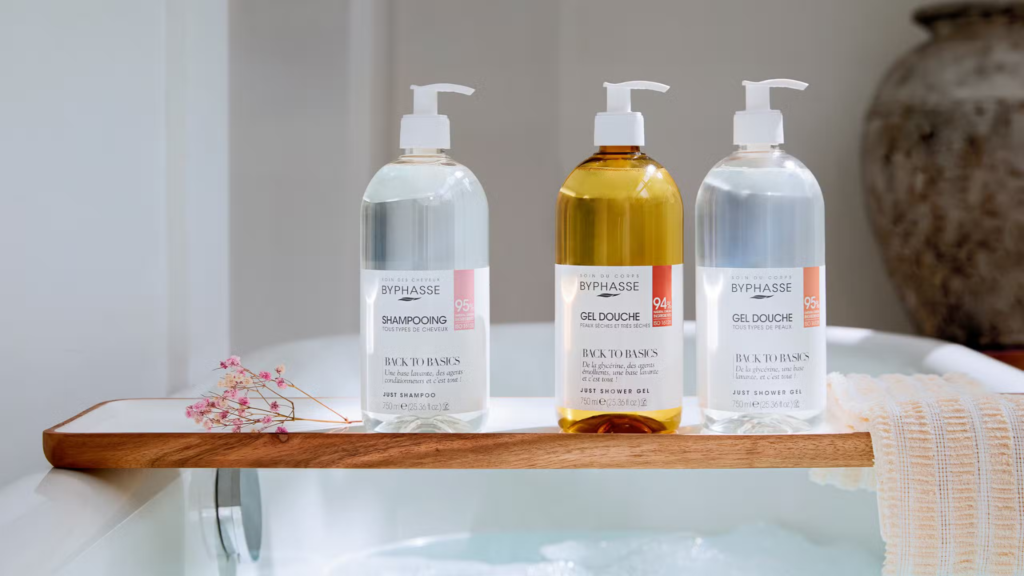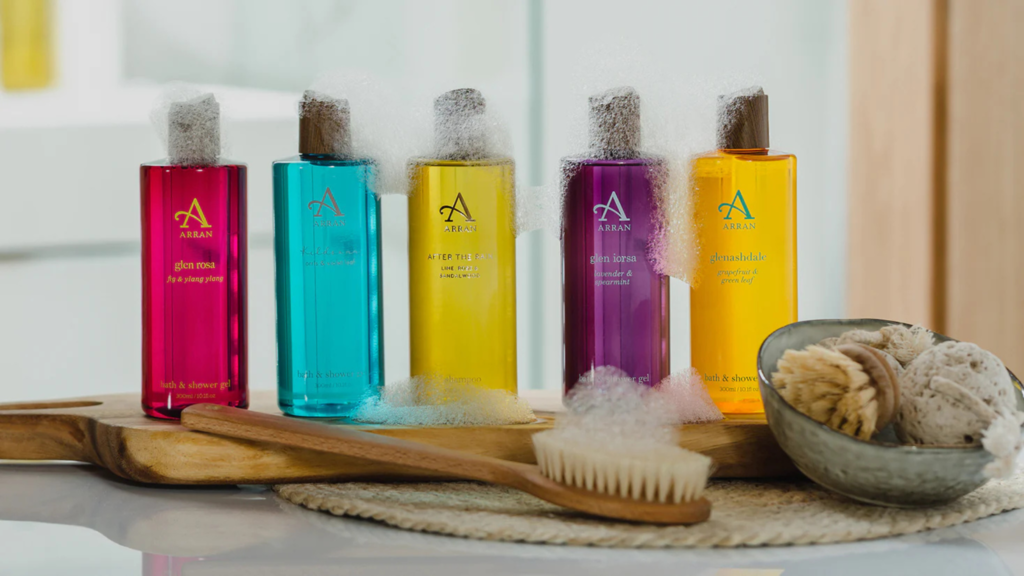A quarter-sized amount of shower gel is all you need to wash your entire body.
Many people use too much shower gel or don’t apply it the right way. This can harm your skin’s health. Your skin takes 2-4 weeks to get used to new shower gels. Rough scrubbing can damage your skin’s natural protective barrier.
The right way to use shower gel makes a big difference, whether you prefer your hands or a loofah. These cleansers work better than regular soaps and you can use them daily. You just need to know the right techniques to get the best results.
You’ll learn the right amount to use and the best ways to apply shower gel that keeps your skin clean and healthy. Let’s take a closer look at the steps to clean your skin perfectly!
Understanding Shower Gel Basics

Shower gels differ from traditional soaps because of their liquid form. They contain about 70% water and 20% surfactants. These balanced percentages help clean effectively without damaging your skin.
How to use shower gel: What makes shower gel different from soap
Traditional soaps use saponified oils, but shower gels use synthetic detergents that come from petroleum or plant sources. The pH value stays lower than traditional soaps, which makes them easier on your skin.
The gel texture lets manufacturers add more moisturizing ingredients. This makes them great for people who live in warm climates or have oily skin.
Key ingredients to look for
A quality shower gel should have these important components:
- Natural Cleansers: You’ll want glycerine-based cleansers and plant-based surfactants
- Moisturizing Agents: Look for coconut oil, shea butter, and aloe vera
- Hydrating Components: Watch for glycerin, hyaluronic acid, and natural plant extracts
- Essential Oils: Tea tree, peppermint, or citrus oils will give antimicrobial benefits
On top of that, good shower gels contain thickening agents that create the right consistency and emulsifiers that keep ingredients from separating. People with sensitive skin should stay away from parabens, phthalates, and heavy fragrances.
How shower gels clean your skin
Shower gels clean using advanced surfactant technology. These surfactants have both hydrophilic (water-loving) and lipophilic (oil-loving) properties. They break down dirt, oils, and impurities on wet skin, so water can wash them away easily.
Surfactants can make up half of the shower gel’s content and work with other ingredients to thicken, preserve, and add scent. Manufacturers often mix multiple surfactants together.
This creates the best cleaning power without irritating your skin. The sophisticated mix gives you a deep clean while keeping your skin comfortable.
Choosing the Right Shower Gel

You need to think over your skin’s unique needs to pick the right shower gel. First, we need to know your skin type to narrow down the wide range of products you can choose from.
Matching gel to your skin type
Cream-based formulas with lipid-replenishing agents work best for dry skin. These products often have olive oil, aloe vera, or honey that deeply moisturize and condition the skin.
People with oily skin do better with gentle formulas that clean without disrupting their skin’s natural balance.
You should look for shower gels with mild exfoliating ingredients to help regulate sebum production instead of harsh antibacterial products.
Hypoallergenic formulas with minimal ingredients work best for sensitive skin. Products that contain oatmeal or chamomile can help soothe irritation and reduce inflammation.
Reading product labels effectively
Product labels list ingredients in descending order by weight. The first 3-4 ingredients make up most of the formula.
Everything you should look for includes:
- Glycerin for moisture retention
- Natural cleansers like coco-glucoside
- Soothing agents such as aloe vera or oatmeal
- Plant-based oils for nourishment
Watch out for products that contain parabens, synthetic fragrances, or methylisothiazolinone since these can trigger skin sensitivities. Shorter ingredient lists often point to cleaner formulas with fewer potential irritants.
Quality certification logos help you line up products with your values. To cite an instance, products accepted by the National Eczema Foundation work well for sensitive skin.
Labels use terms like “fragrance-free” and “unscented” differently. Fragrance-free products have no added scents and work best for sensitive skin. Unscented products might still use masking fragrances.
Step-by-Step Application Guide
The right sequence of steps makes shower gel application more effective. The water temperature plays a vital role in how well your cleansing routine works.
Preparing your skin
Your shower water should be lukewarm since very hot water can strip natural oils from your skin. Let the water run over your whole body to open your pores.
You should finish washing your hair before using shower gel. This prevents product residue from settling on your cleaned skin.
How to use shower gel: The correct amount to use
A quarter-sized amount of shower gel is enough for your whole body. Using too much leads to product waste and makes rinsing harder. The gel works best when focused on areas that produce odor and sweat, like armpits, feet, and groin.
Application techniques
- Add the shower gel to your preferred bathing tool:
- Loofah: Excellent for exfoliation
- Washcloth: Gentle on sensitive skin
- Hands: Direct application option
Mix the gel with water to create a rich lather. Begin at your neck and move downward with gentle circular motions. This method will give a full cleansing while protecting your skin from irritation.
Proper rinsing methods
A complete rinse prevents residue from building up. Warm water helps remove all soap suds, and you should pay extra attention to areas with skin folds. Lift your arms and legs to make sure you remove all the product.
The best way to dry off is to pat your skin with a soft towel instead of rubbing, which might irritate your skin. People with dry skin can leave their skin slightly damp before applying moisturizer. This helps lock in hydration.
Tools and Application Methods
Your shower gel’s effectiveness depends on picking the right application tool. We used clean hands as the safest and most hygienic option to apply shower gel.
How to use shower gel: Using with hands vs loofah
Clean hands have several advantages over other methods. Using hands will give a gentle touch against the skin and protect its natural barrier. Loofahs can boost exfoliation but need careful maintenance to stay bacteria-free.
Clean hands work best if you create a proper lather by rubbing the gel between your palms before applying it. This method works great for people with sensitive skin or active breakouts.
Loofah users should follow these maintenance steps:
- Replace natural loofahs every 3-4 weeks
- Clean weekly with diluted bleach solution
- Store in a well-ventilated area outside the shower
- Allow complete drying between uses
Best tools for different skin types
Each tool works differently for various skin types and concerns:
For Sensitive Skin: Clean hands or soft washcloths are ideal because they clean gently without too much abrasion. Silicone scrubbers are another gentle option that comes with antimicrobial properties.
For Oily Skin: Exfoliating gloves or dry brushes help remove excess oil and clear clogged pores. These tools also work great on rough patches on knees and elbows.
For Normal to Dry Skin: Washcloths provide a balanced cleaning that’s gentler than loofahs. You can easily wash them, which makes them more hygienic than other options.
For Acne-Prone Skin: Stay away from harsh scrubbing tools as they might make breakouts worse. Antimicrobial silicone scrubbers or clean hands are better choices to prevent bacteria spread.
Your shower gel works best when you choose the right tool and maintain it properly. Wash your washcloths after each use. Silicone scrubbers need regular cleaning but last longer because they’re non-porous.
Note that gentle pressure during application keeps your skin barrier safe. People with recurring skin infections or sensitivities often find that switching to hands-on applications fixes these problems.
Common Mistakes to Avoid
You might think it’s impossible to make mistakes with shower gel.
All the same, some errors can harm your skin health and reduce how well the product works. Learning about these common mistakes helps you get the best cleaning results.
Over-usage problems
We used to think daily showers were good, but washing more than once a day removes your skin’s natural oils and good bacteria.
Your body responds to too much washing by making extra oil. This creates an endless cycle where you feel the need to wash more.
Using too much product is also a problem. More than a quarter-sized amount of shower gel causes:
- Poor rinsing results
- Wasted products and harm to the environment
- Dry, irritated skin
- Unbalanced skin pH levels
How to use shower gel: Temperature considerations
Water temperature is a vital part of how well shower gel works.
Research shows that lukewarm water between 98º and 105º F (36.6º to 46.6ºC) cleans best. Very hot water, on the other hand, hurts your skin in several ways:
Hot water damages your skin’s moisture barrier, which results in:
- Swelling and barrier damage
- Loss of natural skin oils
- Dry and irritated skin
- Possible allergic responses
This becomes worse in winter months because hot showers combined with dry air create a double threat to your skin’s barrier. Using moderate water temperature keeps your skin healthy while getting you clean.
Storage errors
The right storage makes a big difference in how well your shower gel works and lasts. Without doubt, bathrooms create perfect conditions for bacteria to grow, so proper storage is vital.
Try these storage tips:
- Keep products away from water spray
- Use well-ventilated spots to stop bacteria growth
- Close bottles properly after use
- Check expiration dates and product texture
Your shower creates special storage challenges. Shower gels usually stay fresh for 9 months after opening. Good storage helps products last longer and stays clean.
The way you organize your bathroom affects both product quality and the environment. Bad storage wastes products and increases plastic use. Think about using refills or environmentally responsible options to help the environment.
Note that bathroom moisture affects product quality. Using the bathroom fan during and after showers controls moisture and stops mold while keeping products fresh.
Conclusion
Using shower gel might seem simple, but proper application makes the most important difference to your skin’s health and cleanliness. Your skin type helps you pick the right product, and the correct application methods ensure the best results.
A quarter-sized amount is enough to clean your entire body. Clean tools, the right water temperature, and good storage habits play key roles in your skin’s health and the product’s effectiveness.
Lukewarm water and gentle application protect your skin’s natural barrier while ensuring deep cleansing. These simple tips will give your skin a healthy, radiant glow.




